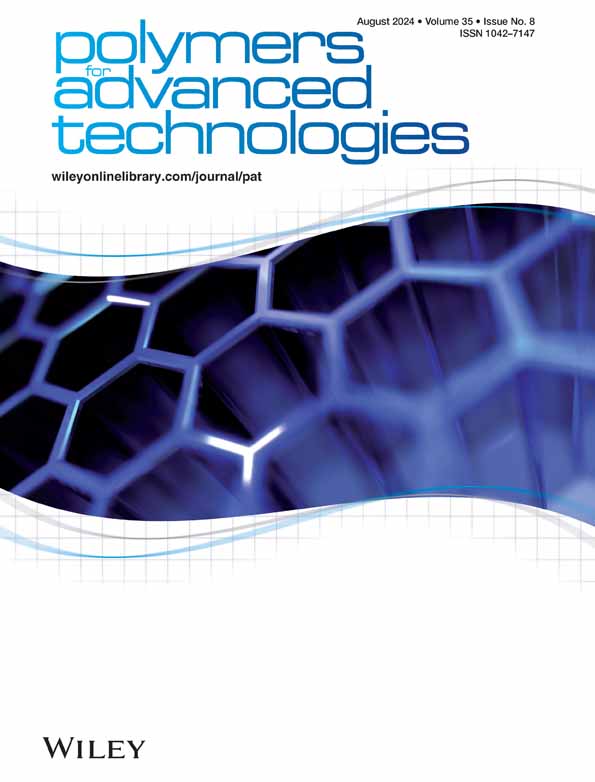Effect of crystalline phase formed by compound flame retardant on the flame retardancy and ceramization of polyethylene composites
IF 3.4
4区 工程技术
Q2 POLYMER SCIENCE
引用次数: 0
Abstract
Ceramic polyolefin composites have the capability to transform into hard ceramics when exposed to fire conditions. During the ceramization process, the formation of new crystalline phase plays a crucial role in enhancing flame‐retardant and ceramifiable properties. Consequently, ceramic polyolefin composites show great potential for the applications in fire‐resistant wires and cables. In this article, the incorporation of the compound flame retardant consisting of ammonium polyphosphate/melamine cyanurate/zinc borate (APP/MCA/ZB) was found to enhance the flame retardancy and ceramization of polyethylene/wollastonite fiber/phosphate glass frits (PE/WF/PGF) composites. The results indicated that ceramifiable flame‐retarding PE composites with compound flame retardant exhibited superior flame retardancy compared to pure PE and PE composites with a single flame retardant. Specifically, the limiting oxygen index (LOI) was significantly increased to 26.8%, and the vertical combustion test rating in UL‐94 (test for flammability of plastic materials for parts in devices and appliances) reached V‐0. During the heating process, ZB thermally decomposed to produce 2ZnO ⋅ 3B复合阻燃剂形成的结晶相对聚乙烯复合材料阻燃性和陶瓷化的影响
陶瓷聚烯烃复合材料在遇火条件下可转化为坚硬的陶瓷。在陶瓷化过程中,新晶相的形成对提高阻燃性和可陶瓷化性能起着至关重要的作用。因此,陶瓷聚烯烃复合材料在耐火电线电缆的应用中显示出巨大的潜力。本文发现,加入聚磷酸铵/三聚氰胺/硼酸锌(APP/MCA/ZB)复合阻燃剂可提高聚乙烯/硅灰石纤维/磷酸盐玻璃熔块(PE/WF/PGF)复合材料的阻燃性和陶瓷化性能。结果表明,与纯聚乙烯和含单一阻燃剂的聚乙烯复合材料相比,含复合阻燃剂的可陶瓷化阻燃聚乙烯复合材料具有更优异的阻燃性。具体来说,极限氧指数(LOI)显著提高到 26.8%,在 UL-94(设备和电器部件塑料材料可燃性测试)中的垂直燃烧测试等级达到 V-0。在加热过程中,ZB 热分解生成 2ZnO ⋅ 3B2O3,与 CaSiO3 反应生成硅酸盐玻璃中间相(CaO ⋅ SiO2 ⋅ 2ZnO ⋅ 3B2O3)。APP 热分解产生 (HPO3)n,与 2ZnO ⋅ 3B2O3 反应形成磷酸盐玻璃中间相(nP2O5 ⋅ 2ZnO ⋅ 3B2O3)。这两种玻璃相与 WF 发生共晶反应,最终形成新的磷酸钙锌结晶相(CZP,Ca19Zn2(PO4)14)。这种新形成的 CZP 相使烧结陶瓷更加致密,抗折强度更高。烧结后陶瓷残渣的抗弯强度为 11.68 兆帕,满足实际应用的要求。
本文章由计算机程序翻译,如有差异,请以英文原文为准。
求助全文
约1分钟内获得全文
求助全文
来源期刊

Polymers for Advanced Technologies
工程技术-高分子科学
CiteScore
6.20
自引率
5.90%
发文量
337
审稿时长
2.1 months
期刊介绍:
Polymers for Advanced Technologies is published in response to recent significant changes in the patterns of materials research and development. Worldwide attention has been focused on the critical importance of materials in the creation of new devices and systems. It is now recognized that materials are often the limiting factor in bringing a new technical concept to fruition and that polymers are often the materials of choice in these demanding applications. A significant portion of the polymer research ongoing in the world is directly or indirectly related to the solution of complex, interdisciplinary problems whose successful resolution is necessary for achievement of broad system objectives.
Polymers for Advanced Technologies is focused to the interest of scientists and engineers from academia and industry who are participating in these new areas of polymer research and development. It is the intent of this journal to impact the polymer related advanced technologies to meet the challenge of the twenty-first century.
Polymers for Advanced Technologies aims at encouraging innovation, invention, imagination and creativity by providing a broad interdisciplinary platform for the presentation of new research and development concepts, theories and results which reflect the changing image and pace of modern polymer science and technology.
Polymers for Advanced Technologies aims at becoming the central organ of the new multi-disciplinary polymer oriented materials science of the highest scientific standards. It will publish original research papers on finished studies; communications limited to five typewritten pages plus three illustrations, containing experimental details; review articles of up to 40 pages; letters to the editor and book reviews. Review articles will normally be published by invitation. The Editor-in-Chief welcomes suggestions for reviews.
 求助内容:
求助内容: 应助结果提醒方式:
应助结果提醒方式:


